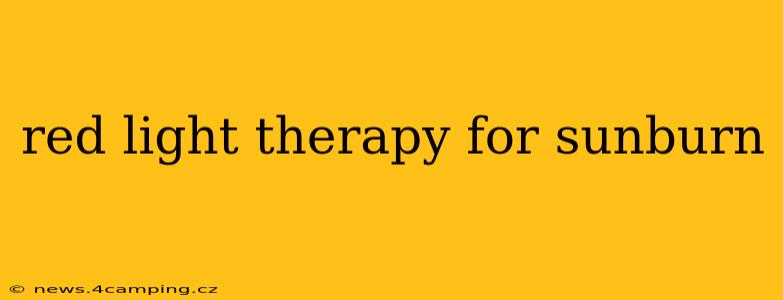Sunburn, that unwelcome souvenir from a day spent basking in the sun, can leave you feeling uncomfortable and looking less-than-ideal. While traditional remedies like aloe vera and cool compresses offer some relief, red light therapy (RLT) is emerging as a promising treatment option for soothing sunburns and promoting faster healing. This comprehensive guide explores the potential benefits, safety considerations, and how red light therapy can be incorporated into your sunburn recovery plan.
Does Red Light Therapy Help Sunburns?
Yes, red light therapy shows promise in treating sunburns. The specific wavelengths of red and near-infrared light used in RLT are believed to stimulate cellular regeneration and reduce inflammation. This can translate to faster healing times, reduced pain and discomfort, and potentially less noticeable scarring. While more large-scale clinical trials are needed to definitively confirm its efficacy, existing research and anecdotal evidence suggest a positive effect.
How Does Red Light Therapy Work for Sunburns?
RLT works by penetrating the skin's layers, interacting with mitochondria—the powerhouses of our cells. This interaction boosts cellular energy production, promoting the repair and regeneration of damaged skin cells. Furthermore, RLT has anti-inflammatory properties that can reduce swelling, redness, and pain associated with sunburn. The increased blood circulation stimulated by RLT also aids in delivering oxygen and nutrients to the affected area, accelerating the healing process.
What Wavelengths are Best for Sunburn Treatment?
The optimal wavelengths for treating sunburns with red light therapy generally fall within the 630-700nm (red light) and 810-850nm (near-infrared) range. Red light penetrates the superficial layers of the skin, targeting inflammation and promoting healing. Near-infrared light penetrates deeper, stimulating cellular repair and reducing pain. Many devices offer a combination of these wavelengths for comprehensive treatment.
Is Red Light Therapy Safe for Sunburns?
Generally, red light therapy is considered safe for treating sunburns. However, it's essential to follow the manufacturer's instructions carefully and avoid overexposure. While RLT is not known to cause further damage to sunburned skin, prolonged or excessive use could potentially lead to discomfort or mild irritation. Always start with shorter treatment sessions and gradually increase the duration as tolerated. If you experience any adverse reactions, discontinue use and consult a healthcare professional.
How Often Should I Use Red Light Therapy for Sunburn?
The frequency of RLT treatments for sunburns varies depending on the severity of the burn and individual responses. A typical approach involves short sessions (10-20 minutes) once or twice daily. Listen to your body; if the treatment feels uncomfortable, shorten the duration or decrease the frequency. Consistent treatment is generally recommended for optimal results.
How Long Does it Take to See Results with Red Light Therapy for Sunburn?
The time it takes to see noticeable improvement varies depending on factors like the severity of the sunburn, the individual's healing capacity, and the consistency of treatment. Some users report relief from pain and redness within a few days, while others may see a significant reduction in overall sunburn symptoms within a week. Remember that healing takes time, and RLT accelerates this process, not providing instant relief.
Can I Use Red Light Therapy with Other Sunburn Treatments?
Red light therapy can often be used in conjunction with other sunburn treatments, such as aloe vera, cool compresses, and over-the-counter pain relievers. However, it's always advisable to consult a dermatologist or healthcare professional before combining different treatments to ensure there are no contraindications or potential interactions.
Conclusion:
Red light therapy presents a promising, non-invasive approach to alleviating the discomfort and accelerating the healing of sunburns. While further research is needed to establish definitive conclusions, the current evidence suggests RLT can be a valuable addition to your sunburn recovery strategy. Remember to always use RLT responsibly, adhering to the manufacturer's guidelines and consulting a healthcare professional if you have any concerns or underlying health conditions.
